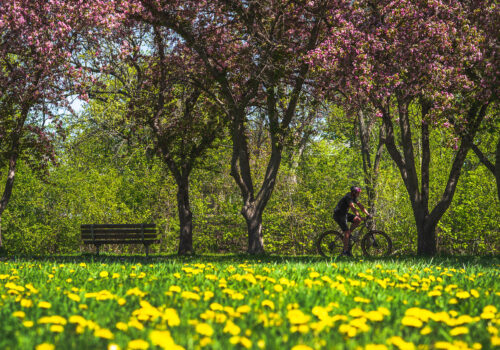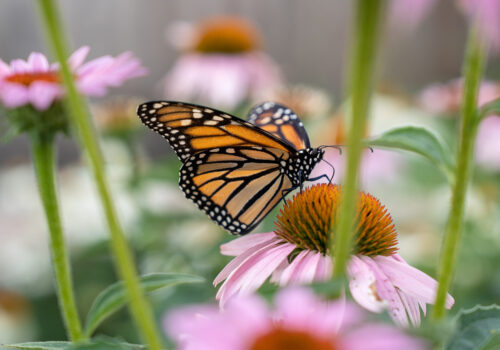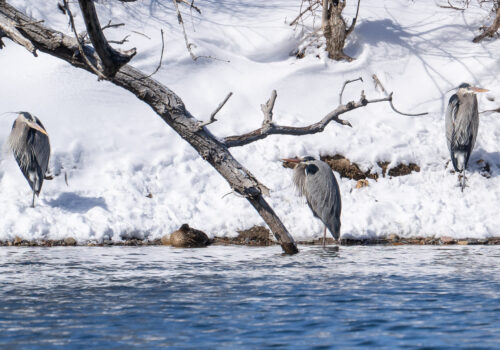Everything You Need to Know About Fall Yard Care (Updated)
Yard care always has an impact water quality, but fall is an especially critical time for waterbodies. Falling leaves are packed with nutrients like phosphorus and nitrogen that find their way into rivers, lakes, and wetlands via stormsewers. Once in the water, excess nutrients from leaf litter can trigger a chain reaction of ecological problems.
For this reason, proper fall yard care leads to healthier, cleaner rivers and lakes. That’s not the only reason to be mindful about your yard this season. Proper fall yard care practices lead to a healthier, more vigorous spring growing season. They can also support pollinators and other beneficial insects by helping them survive the winter.
In this fall yard care guide, we’ll discuss the pros and cons of various leaf-management options, and also talk about fall planting, aerating, and other sustainable practices that can help set up your lawn and garden for success next year.
We’ve also put together a short video (below) to introduce you to the basics of fall yard care.
The Problem: Excess Nutrients
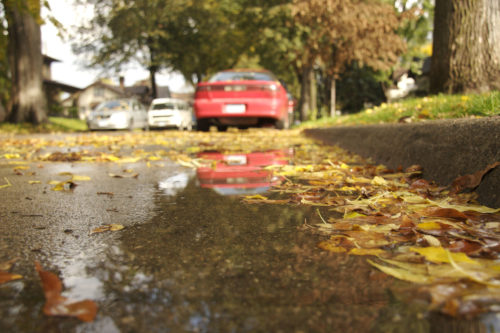
Leaves are packed with potent nutrients like phosphorus and nitrogen. When trees shed their leaves, they restock the earth below with the raw materials that plants need to grow and thrive. In a natural landscape, this is a good thing: The decomposing leaves fertilize the soil, and leaf litter becomes habitat for insects and other wildlife to hunker down and survive the winter.
In urban areas, however, leaves can become a source of pollution. Hard surfaces like streets, parking lots and buildings prevent the nutrients from entering the soil. Instead, the leaves pile up along curbs and in the streets, and rain and melting snow carries this nutrient-rich leaf matter into stormdrains. From there, it flows directly into nearby bodies of water. (In the MWMO watershed, most of it goes directly into the Mississippi River.)
Once in the water, these nutrients feed algae growth, which in turn starves the water of oxygen, killing fish and ultimately disrupting whole ecosystems. This harms water quality for humans as well as wildlife. And like other types of water pollution, it impacts those who live downstream as well.
Rake, Mulch or Compost? What You Should Know
So now we know why letting leaves pile up in the streets is a bad thing. But letting whole leaves pile up on your lawn can also be bad. Why? For one thing, a lot of those leaves will eventually get blown into the streets, clogging stormdrains or washing into stormsewers. For another, leaf litter can form a soggy, decaying mat that can smother your turfgrass lawn, potentially exposing it to mold and disease.
You’ll want to pick a strategy to properly manage your leaves. Raking, mulching, or composting are the most common methods. You can also leave some of the leaf litter behind as insect habitat in spaces like garden beds, raingardens, or in other parts of your yard where the leaves will stay securely in place all winter-long. Doing so will help pollinators and other creatures survive the harsh winter and emerge again in the spring.
Raking
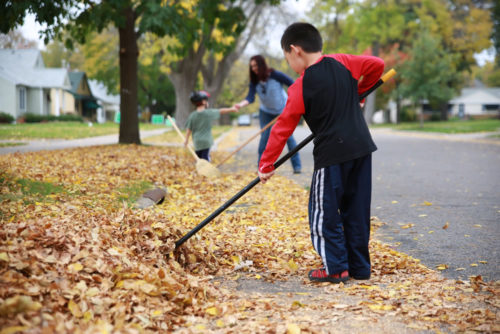
Raking is a time-honored fall tradition — and for many, it’s the simplest and cheapest option for managing leaves. The only necessary supplies are a rake, some yard waste bags, and some free time. Many cities offer curbside pickup of yard waste, which makes proper disposal a breeze. (Pro tip: be sure to check the final pickup date of your city’s curbside yard waste service, or you could be stuck with bags of leaves to store over the winter.)
The biggest mistake people make when raking is stopping at the boulevard. Do the environment and your block a favor by raking up the leaves that fall in the street as well. Don’t assume that the street sweepers can time leaf pickup around weather events. In the fall, snow may prevent city equipment from picking up leaves. And, in the spring, the first good rainstorm will send them into the stormsewers.
Be aware that stormdrains clogged with leaves can also cause localized flooding. By raking or sweeping leaves out of stormdrains on your street, not only are you keeping waterbodies cleaner; you are also protecting your neighborhood. Consider adopting a stormdrain or two in your neighborhood to help manage pollution and reduce potential flooding.
Mulching
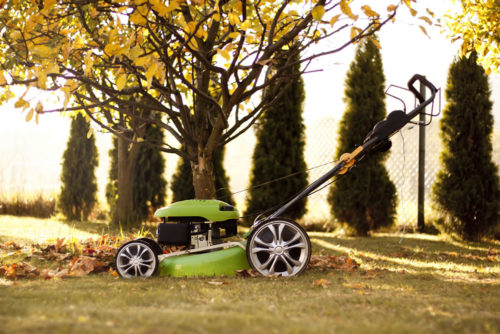
Recently, experts have begun advocating for mulching leaves rather than raking and bagging them. In addition to being faster and easier than raking, mulching keeps your lawn healthy by fertilizing it. (Mulching your leaves with a lawn mower is equivalent to adding a round of fertilizer to your soil every time you mow.)
From an environmental perspective, mulching is also good because it chops up the leaves into small bits that are better held in place by the turfgrass while they decompose. This keeps them out of the streets and away from stormdrains. Just make sure you mulch regularly — that way leaves won’t pile up to a point where they’re too thick for your mower to handle them.
A good rule of thumb: If your lawn looks like it is more than 50 percent covered by leaves, consider raking and bagging them instead of mulching. And again, don’t forget about all the leaves in the street. Rake them onto your lawn and then mulch or bag them.
Composting
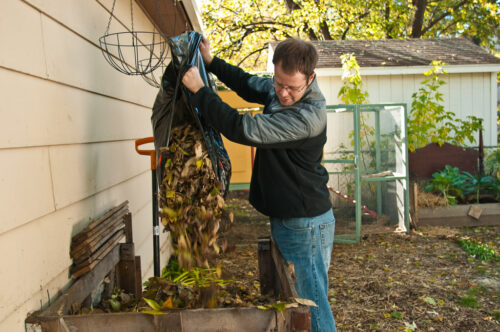
Leaf litter provides excellent fuel for a backyard compost bin. Although there’s a learning curve for novice composters, home composting of yard and food waste can provide a healthy, sustainable, and organic source of compost that can be used as a soil amendment or as mulch.
The science of composting is too large to delve into here. For those interested in learning more about backyard composting, we recommend checking out the Minnesota Composting Council’s website. Clean Water Minnesota also put together a handy downloadable guide that covers the basics.
Piling/Storing
Finally, for those who want to support pollinators and other beneficial wildlife at home, there is a fourth option for managing leaf litter: just leave it.
Pollinators use leaves and other dead plant material as habitat in the winter. They need it to survive until late spring, when they emerge from their hiding places to begin their work. The trick is to find spaces to store leaves where they won’t cause problems or be carried away by the wind.
Raingardens, native planting areas and garden beds are often good places to store leaves. If you go this route, you’ll want to make a plan for what to do with the leaves next spring. Ideally, you’ll want to leave them long enough for pollinators to emerge from their winter hideouts, but not so long that it smothers any desired plant growth. Check out our blog posts on pollinator-friendly spring yard care and spring native plant maintenance.
Setting Up for a Healthy Spring Yard
Leaves are not the only thing you should think about in the fall. If you have bare patches of soil in parts of your yard, or if you’ve been thinking about installing some new native plants as pollinator habitat, fall is a great time of year for planting. In this section, we’ll tell you how to prepare your yard for a healthy spring rebound using simple, organic methods that avoid the use of expensive and potentially harmful chemical fertilizers.
Planting
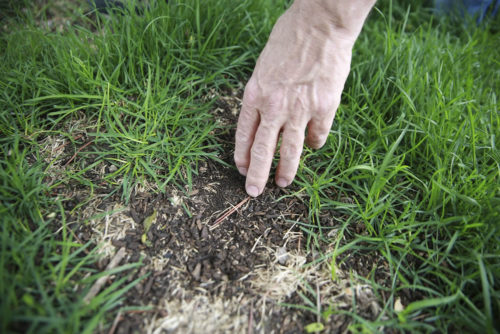
Fall is generally the best time for planting grass seed and native prairie seed mixes in Minnesota. The season’s moderate temperatures help the seeds germinate at the same time established plants and weeds are going dormant, which gives the new seedlings a better shot at survival. (Check out our video on planting pollinator lawns.)
Fixing bare spots in your lawn should be a priority, as growing new grass in bare patches helps prevent soil erosion. This helps keep sediment — another common water pollutant — away from stormdrains and waterbodies. Try to plant hearty grass varieties that will grow well in your yard’s particular soil and lighting conditions. The University of Minnesota Extension offers a good overview of the seeding process for repairing patchy lawns, and Clean Water Minnesota has a handy tip sheet on organic lawn restoration (PDF).
If you’re tired of caring for your turfgrass and not interested in planting more of it, fall is also a great time for installing native flowers, grasses, shrubs, or trees. (Check out our fall planting video.) In addition to providing much-needed habitat for pollinators, mature native plants take less watering and are great for managing stormwater runoff. We’ve got an overview of the benefits of native plants here, along with some links that will help you get started planting them.
Aerating
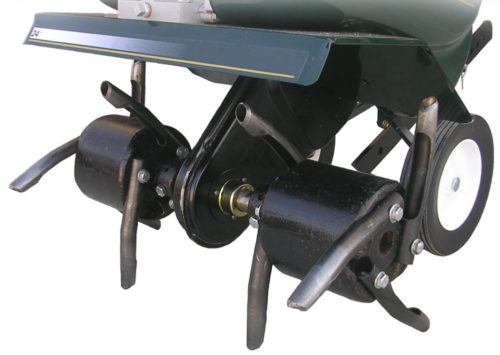
One of the simplest ways to strengthen your turfgrass is by aerating it, and fall is the perfect time of year to do it.
Aeration involves punching small holes in your yard. It loosens compacted soil and helps to circulate air, water and nutrients in the ground. This leads to a healthier lawn that will require less fertilizer and other chemicals to maintain. You don’t need to aerate every year; once every couple of years will do.
You can aerate small areas by hand with a shovel or a spading fork. For larger areas (like entire lawns), you can rent a self-propelled core aerator from your local equipment rental shop for around $40–$50. Water your lawn the night before, to help loosen the soil. And don’t worry about the little plugs of dirt and grass it leaves behind; these will break down over time.
What About Fertilizer?
Fall is also the traditional time of year to apply chemical fertilizer to one’s lawn. Unfortunately, fertilizer is also a major source of excess nutrients in our waterbodies. Due to its environmental impacts, we generally advocate for avoiding the use of fertilizer — or at least using as little as absolutely necessary.
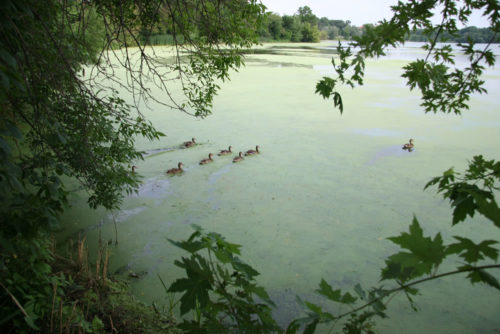
If your turfgrass is in rough shape and you think you need fertilizer, try using organic lawn care methods first. Choosing the right grass seed and planting it properly, combined with practices like mulching, aeration, and other smart lawn care techniques, may be as effective or better than expensive chemical fertilizers.
If organic lawn care methods don’t seem to do the trick and you think you might need fertilizer for your turfgrass, consider having the University of Minnesota test the soils in your yard before you buy any product. The test is inexpensive, and you’ll get great information on what kind of fertilizer will work best for your lawn.
If testing indicates that you do need fertilizer, choose zero-phosphorus fertilizers that are better for the environment. Also, avoid weed-and-feed combinations, which may include chemicals that won’t treat the type of weeds in your lawn or might not keep grass healthy in your particular lawn conditions. Instead, choose products that kill specific weed-types you’re dealing with or address lawn issues in your unique situation.

